Climate Change Canaries and Our Changing Climate
Personal_Finance / Climate Change May 26, 2018 - 07:39 PM GMTBy: Richard_Mills
 Climate change is the buzz word of the 21st century along with its controversial cousin, “global warming,” with both cited frequently as explanations for evidence of our planet in ecological flux. This includes freak winter storms that appear to contradict the “warming” thesis, scorching summer droughts, water shortages, rising sea levels, retreating glaciers, melting permafrost, skinny polar bears, dying coral reefs and the extinction of species.
Climate change is the buzz word of the 21st century along with its controversial cousin, “global warming,” with both cited frequently as explanations for evidence of our planet in ecological flux. This includes freak winter storms that appear to contradict the “warming” thesis, scorching summer droughts, water shortages, rising sea levels, retreating glaciers, melting permafrost, skinny polar bears, dying coral reefs and the extinction of species.
While there is disagreement over its causes – man-made versus natural – the reality of climate change is an incontrovertible fact. The planet is warming, affecting our weather, our oceans, our growing seasons, even our food, as crops fail, causing shortages and price hikes. Storms are becoming more frequent, and more intense, and droughts are lasting longer.
Ahead of the Herd is putting together a series of articles on climate change. We plan to cover the whole range of global warming causes and effects. Each article will endeavor to explain a facet of climate science that is not only extremely interesting, but also has investment implications. Look for the articles on Fridays and in our weekly Ahead of the Herd newsletter which is sent out each Saturday morning. This first article will talk about the main theories of global warming - what they are, what does the evidence show, and where could we be going?
Climate canaries
It’s easy to blame weather events and other geological and ecological aberrations on climate change when the reality is that there are a lot of meteorological and climatic events going on that obscure a definitive diagnosis. All we can do is notice historical patterns, which over time, point to trends that are difficult to refute.
A good example is the hurricanes that battered the US Gulf Coast, Eastern Seaboard, Puerto Rico and the Caribbean in the fall of 2017. Were these monster storms due to a changing climate or was it simply a bad year for hurricanes?
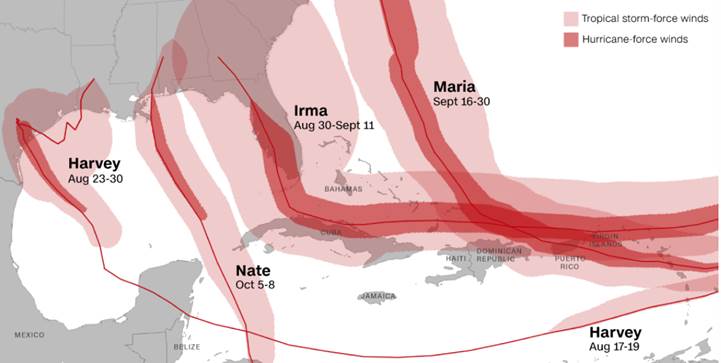
CNN.com
While scientists disagree on the frequency of hurricanes in a world where the ocean is warming (some say there could be less storms but more intense, while others say there will be more of them and in places they didn’t occur before), there are several points of agreement, as stated by Scientific American:
- Higher sea levels mean that storm surges will hit coastlines, whereas when the ocean was cooler, the surges wouldn’t carry as far.
- Climate change will increase the intensity of hurricane rainfall. An example of this was the large amount of flooding in Houston last summer.
- The strongest hurricanes are getting more powerful, because the environment in which all storms occur is warmer and moister.
We can also say with certainty that the temperature on Earth is rising.
According to NASA’s Goddard Institute for Space Studies (GISS), the average global temperature on Earth has increased by about 0.8° Celsius (1.4° Fahrenheit) since 1880.

Current climate models predict that Earth’s average temperature will keep rising.
According to the US Geological Survey, “The evidence of a warming trend over the past century is unequivocal.” Examples of such evidence include streamflow records showing an earlier peak in spring runoff; borehole temperature records in Alaskan permafrost as well as water temperature records on land and sea show the warming trend. Other evidence includes glacial retreat, more intense rainfall, and changes in the timing of plant emergence and spring migrant birds.
The USGS identifies the following as signs of climate change:
- Temperatures are rising world-wide due to greenhouse gases trapping more heat in the atmosphere.
- Droughts are becoming longer and more extreme around the world.
- Tropical storms becoming more severe due to warmer ocean water temperatures.
- As temperatures rise there is less snowpack in mountain ranges and polar areas and the snow melts faster.
- Overall, glaciers are melting at a faster rate.
- Sea ice in the Arctic Ocean around the North Pole is melting faster with the warmer temperatures.
- Permafrost is melting, releasing methane, a powerful greenhouse gas, into the atmosphere.
- Sea levels are rising, threatening coastal communities and estuarine ecosystems.
Global warming alarmists
How concerned should we be about these changing climatic events?
Global warming alarmists are quick to roll out apocalyptic scenarios. In 2015 Rolling Stone published as story titled “The Point of No Return: Climate Change Nightmares are Already Here.” In it, the author writes that “Historians may look to 2015 as the year when shit really started hitting the fan,” giving such examples as heat waves in Pakistan and India that killed over a thousand; a record 98° Fahrenheit was reached in London, the hottest July day ever recorded in the UK; and a 50-acre brushfire in California that happened during the state’s worst drought in 1,000 years - followed up by unusual, intense summer rains.
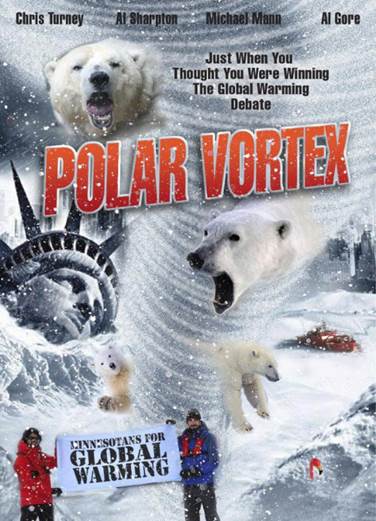 Rolling Stone also quoted a former NASA climatologist saying that mean sea levels could rise 10 times faster than predicted - 10 feet by 2065 - while exceptionally high temperatures in the Pacific Ocean were having weird effects on ocean-dwelling mammals. Humpback whales were spotted close to shore feeding on krill and anchovies in a narrow band of cool coastal water, and great white sharks were seen breeding as far north as Monterey Bay, California.
Rolling Stone also quoted a former NASA climatologist saying that mean sea levels could rise 10 times faster than predicted - 10 feet by 2065 - while exceptionally high temperatures in the Pacific Ocean were having weird effects on ocean-dwelling mammals. Humpback whales were spotted close to shore feeding on krill and anchovies in a narrow band of cool coastal water, and great white sharks were seen breeding as far north as Monterey Bay, California.
Finally the article quoted studies saying that the acidification of the ocean would have a devastating effect on plankton, and that 6% of the world’s coral reefs could disappear by the end of the decade. Ocean “dead zones” where algae blooms suck up most of the available oxygen, are expected to become more numerous.
Interesting that one has to read to the end of the article to discover that the same thing happened 250 million years ago. It was during ‘The Great Dying’ “when more than 90 percent of all oceanic species perished after a pulse of carbon dioxide and methane from land-based sources began a period of profound climate change,” writes the author, who concludes that while the earlier conditions for The Great Dying took hundreds of thousands of years to develop, human-caused global warming only took about 100 years to kickstart “the mass extinction”.
It’s articles like these that, while mostly actual, leave enough doubt in the mind of readers to fuel a growing movement that doesn’t buy human-caused global warming.
Global cooling?
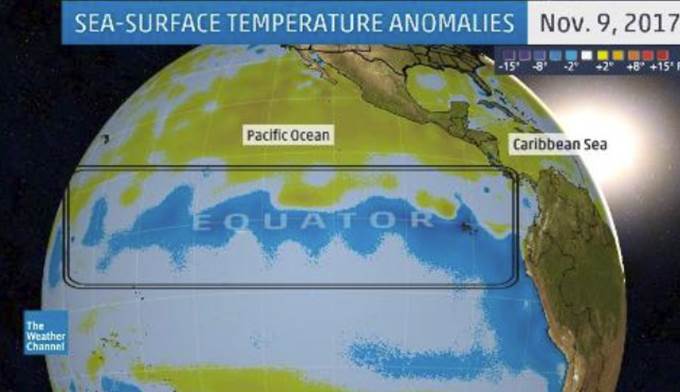
These doubts are sown further when one witnesses cooling trends. If Earth is getting hotter, why is Europe and Russia experiencing some of the coldest winters on record? According to NBC News while 2017 was one of the hottest years, it also saw more snow in the Northern Hemisphere than in the last three decades. That’s 360,000 square miles more than the average snow cover from 1981 to 2010, and the most snow to cover land north of the equator since 1985, NBC reports, quoting data from the National Oceanic and Atmospheric Administration (NOAA), the Rutgers University Snow Lab.
The reason can partially be explained by the El Nino/La Nina weather phenomenon which pushed down global temperatures despite a historical rising trend.
While El Nino helped put global temperatures at a record high in 2016, the next year La Nina lowered them by 1.8° Fahrenheit. But according to NOAA, if the La Nina factor is stripped out, 2017 would have been the warmest year on record.
Polar vortices
Scientists have another answer to the perplexing discrepancy between global warming and cold winters that bring freezing temperatures to parts of Northern Europe and North America. It’s known as “the polar vortex” or polar vortices, since there are actually two, one over the North Pole and one over the South Pole.
The polar vortex is a seasonal atmospheric phenomenon whereby high winds swirl around an extremely cold pocket of Arctic or Antarctic air. The winds are like a barrier that contains the cold air, but when the vortex weakens, the cold air “escapes” from the vortex and travels south, bringing with it a cold blast of Arctic weather. An example of such weakening occurred in 1985 when the northern polar vortex became so distorted that cold air pushed down as far as Florida, destroying the normally balmy state’s orange crop. This past winter, the northern polar vortex stretched its icy fingers towards Eurasia, which saw temperatures plummet to -80° Fahrenheit (-62° Celsius) in Siberia.
How does climate change affect the polar vortices? The answer is warming oceans. As more ice melts during the summer, the Arctic Ocean warms. The effect is less pronounced in Antarctica due to Antarctica being a land form, not a polar ice cap. That heat gets radiated back to the atmosphere in winter, which reduces the intensity of the northern polar vortex winds. The polar vortex gets disrupted, allowing cold air in the center of the swirling cyclone above the pole to migrate south. According to Scientific American, data taken from the past decade prior to 2016 shows that in years when a lot of Arctic sea ice disappeared, the vortex was more likely to weaken.
Along with escaping cold Arctic air that flows into parts of the Northern Hemisphere sometimes unaccustomed to harsh winters, a distorted polar vortex also warms polar regions. Forbes reported in February that temperatures in the Arctic were up to 45° Fahrenheit above average, in the middle of winter. Greenland saw 61 hours of above-freezing temperatures in the first two months of 2018 - much higher than normal.
While occasional breakdowns of the polar vortex are nothing to be concerned about, they are becoming more common. A study in the Bulletin of the American Meteorological Society found that a weakening polar vortex has become more common during the past four decades, Mashable reported, and that a weaker polar vortex, brought on by a melting Arctic, explained 60% of the cooling in Eurasia since 1990.
The scary part of all this is the spectre of the polar vortex collapsing. This would mean a total disruption of normal atmospheric warming and cooling. Without halos of swirling Arctic and Antarctic winds serving to cool the poles, they would be left to heat up, accelerating global warming. Writes Forbes:
What's concerning is the frequency and duration of breakdowns in the polar vortex, indicating its potential collapse. While the strength of the polar vortex relies on the temperature difference between the mid-latitudes and the Arctic we concurrently see increasing average temperatures in the pole. In addition, NASA puts the rate of declining Arctic sea ice at 13.2% per decade. These signs point to a continued weakening of the polar vortex and a potential collapse.
The North Atlantic Current
Also crucial to an understanding of global warming are the changes to the North Atlantic Current, a column of water that extends the Gulf Stream north-east, starting around the Grand Banks of Newfoundland. The current flows east for 11 points of longitude before sharply veering north, transporting warm tropical waters from the Gulf Stream like a giant conveyor belt to northern latitudes and eventually the Arctic Ocean.
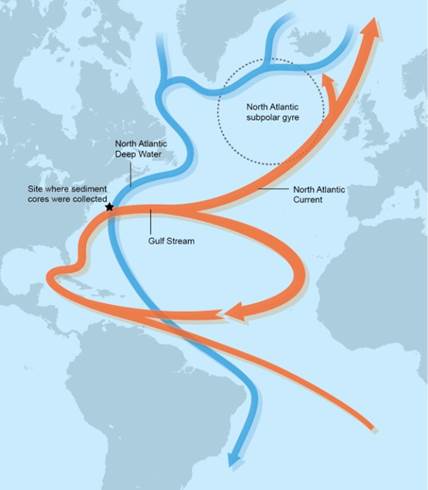
Meanwhile another current, the cumbersome-sounding Atlantic Meridional Overturning Circulation (AMOC), exchanges warm water from the equator with cold water from the Arctic, transporting warm and cold water to the North and South Poles.
Without climatic disruptions the currents work to move water around the globe, along with nutrients key to the survival of marine species.
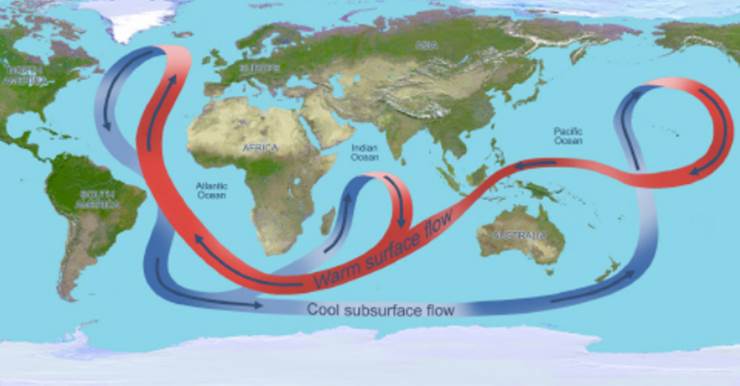
The Gulf Stream, one of four currents known as the North Atlantic Gyre, even played a role in the exploration of the New World, with European explorers catching the winds in their sails from the Gulf Stream as they searched for new lands.
However in recent times climate scientists have been raising concerns that rising temperatures could throw a wrench into the conveyor-like currents system. Sensors stationed along the North Atlantic show that the volume of water moving northward has been sluggish, reports Scientific American - potentially affecting sea levels and weather - but the more disruptive scenario involves the AMOC:
As global temperatures rise with the levels of heat-trapping gases in the atmosphere, the AMOC could be disrupted by an influx of freshwater from increasing precipitation in the North Atlantic and the melting of sea ice and glaciers on land. The added freshwater lowers the water density in the zone where deepwater forms, backing up and weakening the overall flow of the AMOC like a clogged sink. That slowdown means less heat is transported northward, leading to cooler ocean temperatures in a region below Greenland, and warmer temperatures off the U.S. east coast. That warming leads to higher sea levels along the coast and raises sea temperatures where economically valuable cold-loving species like cod and lobster live. - Scientific American
The slowing of the AMOC could also mean colder winters across the eastern US, and increases the likelihood of summer heat waves across Europe.
Two recent studies quoted by NPR show that the amount of water surging through the AMOC has slowed to a 1,000-year low. The doomsday scenario is one that formed the plot line of the movie The Day After Tomorrow, where the current stopped and resulted in an ice age. Although there is evidence that the current did shut down during the last ice age, scientists aren’t concerned that could happen anytime soon. Instead, what they’re looking for is a tipping point where, once reached, the AMOC can’t recover quickly, NPR said. However last year climatologists looking at the possibility of climate change around the Atlantic Ocean said “there is an almost 50% chance that [the Labrador Sea] could cool suddenly and rapidly, within the space of a decade, before the end of this century.” Earlier predictions couldn’t foresee the Atlantic Ocean current shutdown happening for hundreds of years.
Melting ice, rising seas
The warming of the Earth’s surface has caused a widespread retreat of the glaciers at both poles. According to NASA between 2002 and 2006 Greenland lost 60 cubic miles of ice; in Antarctica it was 36 cubic miles from 2002-05. All of this melting ice has caused sea levels to rise, from between seven and eight inches over the last 117 years, NASA states, with the most rise occurring since 1993. The expansion of ocean water as it warms also causes higher sea levels. The latest International Panel on Climate Change report predicts sea levels rising between 52 and 98 centimeters by 2100 if nothing is done to stop rising temperatures. An increase of 65 centimeters, or roughly two feet, is expected to cause significant flooding in coastal cities. Satellite images show sea levels rising 3.2 millimeters a year, with the last measurement, taken in December 2017, recording a rise of 88mm.
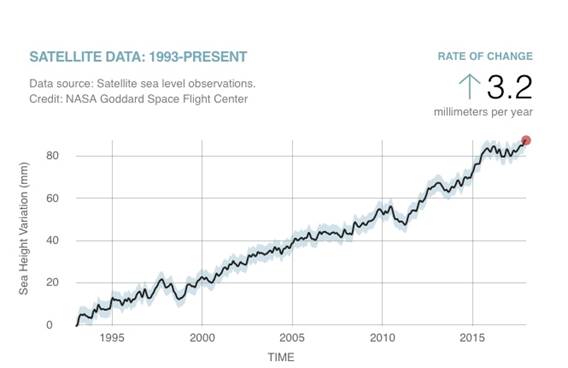
What would happen if the Earth warmed by 3 degrees, just one more degree than currently? According to scientists the effects would be calamitous. With eight out of the 10 largest cities near a coast, several millions would be at risk of flooding, shoreline erosion and storm surges. According to a 2017 Guardian article, the worst-hit cities would be in Asia, including Shanghai, Hong Kong and Osaka. Rio de Janeiro, Miami, The Hague, and Alexandria are also included among the most populated, at-risk cities. Osaka in a 3-degree world would disappear underwater, while in Alexandria, the Egyptian city's beaches would be submerged and 8 million people would be flooded out. Climate Central ranked the 25 US cities most at risk of coastal flooding and sea level rise. It found that New York is most likely to have problems, with Miami second. Twenty-two of the 25 cities are in Florida. Another reports says the most vulnerable areas are in the mid-Atlantic and south-Atlantic states and the Gulf Coast due to their low-lying topography, high economic value and high storm frequency. Parts of New England are also at risk, while the West Coast with the exception of Puget Sound and San Francisco Bay is less likely to get flooded.
While melting glaciers obviously increasing the amount of water flowing into the ocean, we should distinguish between glacier or iceberg retreat and melting sea ice. The latter is frozen water that forms, expands and melts in the ocean, not on land. When sea ice is lost, the sunlight is no longer reflected back to the atmosphere, but rather gets absorbed into the open ocean. This exacerbates ocean warming, and forms a warming cycle. Warmer water temperatures delay the growth of ice in fall and winter, and the ice melts faster in the spring, exposing patches of open ocean for longer periods during summer, and further warming the ocean.
According to a graph from NASA, Arctic sea ice measured in September - when it is thinnest - is now declining at a rate of 13.2% per decade.
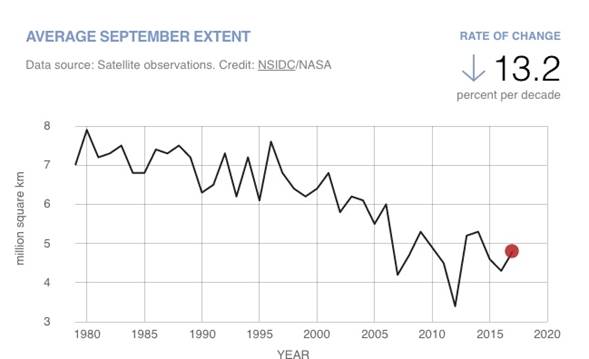
Along with calving glaciers, shrinking ice caps and disappearing sea ice, evidence of Arctic warming can also be seen in the thawing of permafrost. The Guardian said in December that Arctic permafrost in 2017 reached record warm temperatures. Over the past 30 years, the Arctic has warmed more than any other region on Earth.
Desertification
We’ve saved desertification for last as it probably is the most urgent threat to humanity caused by climate change. That’s because human-caused degradation of land, including unsustainable farming, overgrazing, clear-cutting, mis-use of water and industrial activities, can all be intensified and accelerated by global warming. Why is that important? Because according to Luc Gnacadja, executive secretary of the UN Convention to Combat Desertification (UNDD), “The top 20cm of soil is all that stands between us and extinction.”
What does that mean? It means that as we strip away the amount of available land for food production, we are literally depriving ourselves of the means to survive. Eventually this will lead to the destruction of human civilization - just as desertification contributed to the collapse of the world’s earliest known empire, the Akkadians of Mesopotamia.
“A rough calculation of current rates of soil degradation suggests we have about 60 years of topsoil left. Some 40% of soil used for agriculture around the world is classed as either degraded or seriously degraded – the latter means that 70% of the topsoil, the layer allowing plants to grow, is gone.” 2012 TIME interview with Professor John Crawford of the University of Sydney
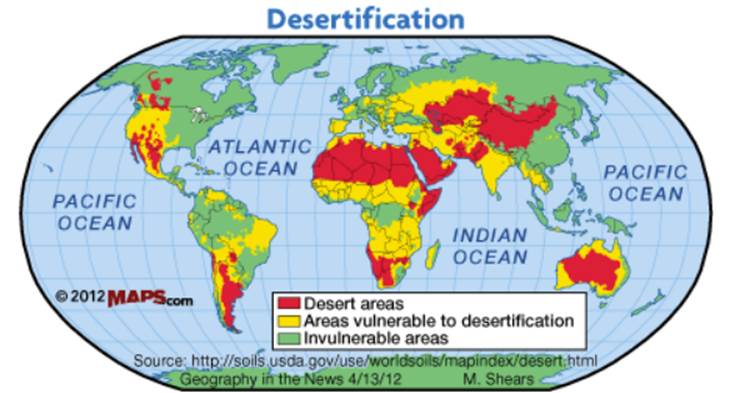
Broadly speaking, desertification refers to the process of turning arable land into desert usually as a result of deforestation, drought or harmful agricultural practices. Removal of vegetation also takes away nutrients from the soil, making the land unsuitable for farming. According to the UNCDD, around 12 million hectares of productive land becomes barren every year as a result of desertification and drought.
Climate change accelerates desertification because warmer temperatures dry out once-fertile land, which then makes the area even hotter. Removing plants from the ground also increases greenhouse gas emissions, since they can no longer serve as carbon sinks.
A recent study quoted in The Independent shows that up to 30% of the world’s land surface would become arid if temperatures rise 2° Celsius above pre-industrial levels.
Desertification is not only bad ecologically, it can also lead to global tensions. Land conflicts in Somalia, dust storms in Asia and food price crises (in Mozambique, Egypt, Serbia and Pakistan) have all been attributed to desertification. The Arab Spring of 2010-11 was sparked by a spike in grain prices a couple of years earlier which meant a 37% rise in the price of bread. Bread in Egypt is called “aish”, or life.
Conclusion
As this article - the first of a series - has demonstrated, the warming of the globe has some profound and wide-reaching implications - not only for our environment but our cities, our food, our safety, and really, our whole way of life. Alterations to climatic systems like the polar vortices and the ocean currents that move water from one ocean to another not only affect weather patterns; the delicate balance of the seasons and the prevention of another ice age depend on their proper functioning. Rising temperatures deplete ice caps, glaciers, and sea ice - which raise the level of the oceans to the point where coastal cities are at risk of being inundated. Those living further inland don’t get away unscathed either. In places like Australia, increased precipitation in winter-time is causing more vegetation to grow, which falls to the ground in summer, creating ideal kindling for raging forest fires. Climate change feeds the disastrous cycle of desertification, putting crops at risk and increasing the chances of conflicts over scarce, and expensive, food.
Next article: Birds, bees, bugs and frogs: going going gone
Climate change is already impacting you and the consequences you feel are going
to intensify and multiply.
If not, maybe it should be.
By Richard (Rick) Mills
If you're interested in learning more about the junior resource and bio-med sectors please come and visit us at www.aheadoftheherd.com
Site membership is free. No credit card or personal information is asked for.
Richard is host of Aheadoftheherd.com and invests in the junior resource sector.
His articles have been published on over 400 websites, including: Wall Street Journal, Market Oracle, USAToday, National Post, Stockhouse, Lewrockwell, Pinnacledigest, Uranium Miner, Beforeitsnews, SeekingAlpha, MontrealGazette, Casey Research, 24hgold, Vancouver Sun, CBSnews, SilverBearCafe, Infomine, Huffington Post, Mineweb, 321Gold, Kitco, Gold-Eagle, The Gold/Energy Reports, Calgary Herald, Resource Investor, Mining.com, Forbes, FNArena, Uraniumseek, Financial Sense, Goldseek, Dallasnews, Vantagewire, Resourceclips and the Association of Mining Analysts.
Copyright © 2018 Richard (Rick) Mills - All Rights Reserved
Legal Notice / Disclaimer: This document is not and should not be construed as an offer to sell or the solicitation of an offer to purchase or subscribe for any investment. Richard Mills has based this document on information obtained from sources he believes to be reliable but which has not been independently verified; Richard Mills makes no guarantee, representation or warranty and accepts no responsibility or liability as to its accuracy or completeness. Expressions of opinion are those of Richard Mills only and are subject to change without notice. Richard Mills assumes no warranty, liability or guarantee for the current relevance, correctness or completeness of any information provided within this Report and will not be held liable for the consequence of reliance upon any opinion or statement contained herein or any omission. Furthermore, I, Richard Mills, assume no liability for any direct or indirect loss or damage or, in particular, for lost profit, which you may incur as a result of the use and existence of the information provided within this Report.
© 2005-2022 http://www.MarketOracle.co.uk - The Market Oracle is a FREE Daily Financial Markets Analysis & Forecasting online publication.



